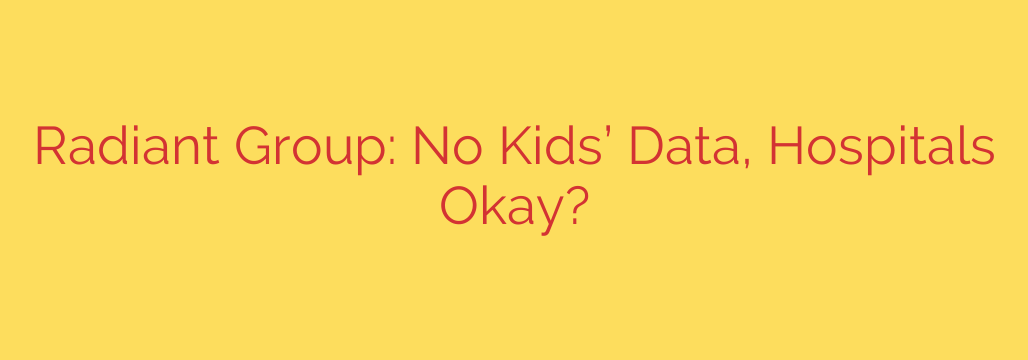
The Troubling Rise of ‘Ethical’ Ransomware: Why Attacks on Hospitals Endanger Everyone
In the shadowy world of cybercrime, a new and unsettling trend is emerging: ransomware gangs attempting to adopt a moral code. A new extortion group, known as Radiant Group, has recently surfaced with a strange and contradictory promise—a pledge not to harm children, while simultaneously declaring hospitals and other critical institutions as fair game.
This development highlights a dangerous new tactic in the world of data extortion, where criminals attempt to manage their public image while continuing to inflict widespread damage. For healthcare organizations and cybersecurity professionals, this serves as a stark reminder that no threat should ever be underestimated.
A New Threat with a Bizarre Promise
Radiant Group has made its mission clear through public statements. The group claims it will not target organizations dedicated to child welfare and has gone a step further with a specific, and frankly, unbelievable promise: If they steal data that includes information on children under 14, they vow not to leak or sell it.
On the surface, this might appear to be a line drawn in the sand, a sliver of morality in an otherwise criminal enterprise. However, this claim immediately falls apart when considering their stated targets. The group has explicitly stated that medical institutions, with the exception of veterinary clinics and plastic surgery centers, are on their list of potential victims. This creates a dangerous paradox: how can a group attack a hospital without inherently endangering the children who are treated there?
The Dangerous Myth of ‘Ethical’ Hacking
Let’s be clear: the notion of an “ethical” ransomware attack is a fallacy. This type of public posturing is not a sign of a moral compass but a calculated business strategy. By pretending to have ethical boundaries, cybercriminal groups aim to:
- Reduce Public Backlash: Appearing to spare children could soften their image and reduce public outrage.
- Lower Law Enforcement Priority: Groups may believe that avoiding overt harm to minors could make them a less urgent target for international law enforcement agencies.
- Encourage Ransom Payments: A victim organization might be more inclined to negotiate with a group they perceive as “reasonable” or having some form of code.
However, these claims are nothing more than a smokescreen. Any cyberattack on a hospital is a direct threat to human life, regardless of the attacker’s hollow promises.
Why Targeting Hospitals Puts All Patients at Risk
When ransomware paralyzes a hospital’s network, the consequences are immediate and devastating. The attackers don’t just steal data; they disrupt the very systems that keep patients alive.
An attack on a hospital’s IT infrastructure can lead to:
- Delayed or Canceled Surgeries: Critical procedures are postponed, putting patient health in jeopardy.
- Inaccessible Patient Records: Doctors and nurses lose access to vital medical histories, allergies, and test results, leading to dangerous diagnostic and treatment errors.
- Compromised Medical Equipment: Life-support systems, imaging machines, and other essential devices connected to the network can be rendered useless.
- Diverted Ambulances: Emergency rooms are forced to turn away new patients, sending them to other facilities and delaying critical care.
These disruptions do not discriminate by age. A child in the pediatric ICU is just as vulnerable as an adult in the cardiac unit when the hospital’s core systems fail. The idea that a ransomware group can attack a hospital without harming children is not just false; it’s absurd.
Actionable Steps for Healthcare Cybersecurity
The claims made by Radiant Group should serve as a wake-up call for all healthcare institutions. The threat is real, and proactive defense is the only viable strategy. Organizations must assume they are a target and take immediate steps to fortify their systems.
Here are essential security measures every healthcare facility should implement:
- Immutable and Air-Gapped Backups: Regularly back up all critical data. Ensure these backups are immutable (cannot be altered or deleted) and stored offline or “air-gapped” where attackers cannot reach them. This is the single most important defense for recovering from a ransomware attack without paying.
- Implement Multi-Factor Authentication (MFA): Protect all accounts, especially those with administrative privileges, with MFA. This adds a critical layer of security that makes it much harder for attackers to gain access using stolen credentials.
- Network Segmentation: Divide your network into smaller, isolated segments. This can contain a breach to one area, preventing it from spreading across the entire hospital system and impacting critical care departments.
- Conduct Regular Employee Training: The human element is often the weakest link. Train all staff to recognize phishing emails, suspicious links, and other social engineering tactics used to initiate attacks.
- Develop a Robust Incident Response Plan: Don’t wait for an attack to happen. Have a clear, practiced plan in place that outlines who to contact, how to isolate systems, and how to communicate with staff, patients, and law enforcement.
Ultimately, there is no honor among thieves. The claims of groups like Radiant are a disingenuous attempt to mask their destructive activities. For healthcare providers, the message is clear: the threat of ransomware is persistent and evolving. Vigilance, preparation, and a commitment to robust cybersecurity are the only things that can protect our most vulnerable institutions and the patients who depend on them.
Source: https://go.theregister.com/feed/www.theregister.com/2025/10/06/radiant_group_hospital/








